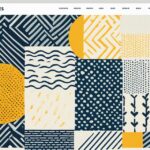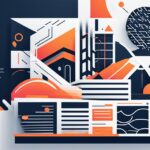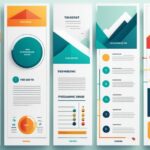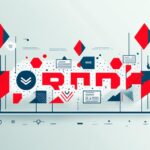Table of Contents
Graphic design is a dynamic field that encompasses creativity, visual aesthetics, and effective communication. In this article, we will explore the world of experimental graphic design on the web, where designers break traditional rules to create captivating and unique designs.
By pushing the boundaries of design principles and embracing new technologies, designers can create visually striking and engaging experiences for their audiences. Whether it’s through innovative approaches, unconventional visuals, or interactive elements, experimental graphic design offers endless possibilities for creating impactful designs that leave a lasting impression.
Throughout this article, we will delve into the importance of understanding traditional design principles as a solid foundation for breaking the rules in graphic design. We will also explore how experimental graphic design can lead to innovative approaches, captivating visual aesthetics, and effective communication.
So, join us on this exciting journey as we dive into the world of experimental graphic design and discover how breaking the rules can create truly remarkable designs.
Traditional Graphic Design Principles: A Solid Foundation
Before embarking on the journey of experimental graphic design, it is crucial to have a solid understanding of the traditional design principles that form the backbone of design. These principles, such as balance, contrast, and hierarchy, serve as guiding forces in creating visually pleasing and effective designs.
Balance involves arranging elements in a way that creates visual stability. When a design is balanced, the distribution of elements on the page feels harmonious and doesn’t favor any particular area. It can be achieved through symmetrical or asymmetrical arrangements.
Contrast plays a pivotal role in creating visual impact. By juxtaposing elements with different properties like size, color, or texture, designers can draw attention to specific areas and create visual interest. Contrast helps establish a hierarchy of importance and guides viewers through the design.
Hierarchy is essential in effectively communicating information within a design. It involves organizing and prioritizing elements based on their importance or significance. By establishing a clear hierarchy, designers can guide the viewers’ attention and enhance the overall comprehension of the design.
By mastering these principles, designers can lay a strong foundation for their experimental design explorations. With a good understanding of balance, contrast, and hierarchy, designers can create visually appealing and effective designs that captivate audiences.
The Role of Balance in Graphic Design
Balance involves arranging elements in a way that creates visual stability.
Balance is a fundamental principle in graphic design that affects the overall composition and visual impact of a design. It refers to the distribution and arrangement of visual elements, such as text, images, and shapes, so that they create a sense of equilibrium. There are two main types of balance commonly used in graphic design:
- Symmetrical Balance: In symmetrical balance, elements are arranged equally on either side of an imaginary central axis. This creates a sense of stability and formality. It is often used in traditional and formal designs.
- Asymmetrical Balance: Asymmetrical balance involves a more dynamic and informal arrangement of elements. It relies on the visual weight, color, size, and texture of the elements to create a sense of balance. It can be used to create a more modern and visually interesting design.
Both types of balance have their unique characteristics and can be used to achieve different design goals. The choice of balance depends on the message and the desired aesthetic of the design.
Here is an example that demonstrates the effective use of balance in graphic design:
| Design | Description |
|---|---|
| A poster design for a music festival showcasing symmetrical balance. The design features a central axis with symmetrical elements on both sides. This creates a sense of formality and visual stability. |
In this example, the symmetrical balance creates a visually pleasing and balanced composition, allowing the viewer to focus on the main elements of the poster.
Breaking the Rules: Innovative Approaches in Experimental Graphic Design
Once designers have a solid foundation in traditional design principles, they can embark on the journey of breaking the rules and exploring innovative approaches in experimental graphic design. Through unconventional techniques, designers can create unique and captivating designs that push the boundaries of creativity.
Experimenting with non-linear layouts is one way designers can challenge traditional design norms. By breaking free from the constraints of a linear structure, designers can create visually interesting compositions that engage viewers in unexpected ways. Non-linear layouts allow for a more dynamic and interactive user experience, driving exploration and discovery.
Typography experimentation is another avenue for designers to defy conventions and create memorable designs. By utilizing custom typefaces and unconventional spacing, designers can evoke a sense of uniqueness and visual impact. Typography becomes not just a means of conveying information, but also an integral part of the overall aesthetic and storytelling.
Unconventional color palettes add another layer of interest and emotion to experimental graphic design. By stepping away from traditional color schemes, designers can evoke unique moods and create visual contrast. Unconventional color choices can grab attention, evoke emotions, and leave a lasting impression.
Incorporating unconventional visuals, such as abstract illustrations or mixed media techniques, can elevate experimental graphic design to new heights. These unconventional visuals break away from traditional imagery, inviting viewers to interpret and engage with the design in their own unique way. By combining different mediums and techniques, designers can create visually rich and dynamic compositions that captivate and inspire.
By embracing non-linear layouts, typography experimentation, unconventional color palettes, and incorporating unconventional visuals, designers can break free from traditional design constraints and create truly innovative and impactful designs.
Examples of Experimental Graphic Design Approaches
| Approach | Description |
|---|---|
| Non-linear layouts | Breaking away from a linear structure to create dynamic and interactive designs. |
| Typography experimentation | Utilizing custom typefaces and unconventional spacing for unique visual impact. |
| Unconventional color palettes | Using unexpected color combinations to evoke emotions and visual interest. |
| Incorporating unconventional visuals | Exploring abstract illustrations and mixed media techniques for visually rich compositions. |
Embracing Technology and Interactivity in Experimental Graphic Design
In today’s digital age, experimental graphic design has transcended the confines of traditional print media. Designers are now harnessing the power of technology and interactivity to create immersive and engaging experiences for their audiences. By embracing cutting-edge tools and techniques, they can elevate their designs to new heights.
Motion graphics and animation play a crucial role in adding dynamism and visual interest to experimental graphic design. Utilizing fluid movements and captivating transitions, designers can captivate their viewers and convey complex ideas with ease. Whether it’s a subtle motion effect or a dynamic animation sequence, motion graphics inject life into static designs, creating a visually stimulating experience for the audience.
Interactive design elements are another integral component of experimental graphic design. By incorporating interactive features, designers can create a sense of engagement and encourage active participation from the audience. Scroll-triggered animations, parallax scrolling effects, and hover interactions are just a few examples of how designers can enhance the user experience and captivate their audience in a truly interactive way.
Virtual reality (VR) and augmented reality (AR) have also revolutionized experimental graphic design. By leveraging these technologies, designers can create immersive experiences that blur the boundaries between the digital and physical worlds. VR allows users to immerse themselves in virtual environments, while AR overlays digital elements onto the real world. Designers can leverage VR and AR to enhance brand experiences, create interactive storytelling, or showcase products in innovative ways.
The Benefits of Embracing Technology and Interactivity
When designers embrace technology and interactivity in experimental graphic design, they unlock a myriad of benefits, including:
- Enhanced user engagement and interaction
- Increased brand memorability
- Opportunities for storytelling through dynamic visuals
- Captivating user experiences that leave a lasting impression
- Expanded creative possibilities and artistic expression
By embracing the power of technology and interactivity, designers can push the boundaries of traditional graphic design and create captivating experiences that resonate with their audience on a deeper level.
The Impact of Breaking the Rules in Experimental Graphic Design
Breaking the rules in experimental graphic design can have several profound effects. By diverging from conventional design practices, designers can create a unique visual identity for brands, establishing a memorable and recognizable presence in the market.
Unconventional designs often elicit emotional responses from viewers and grab their attention. They have the power to evoke a wide range of emotions, from excitement to curiosity, creating a lasting impact on the audience.
Incorporating innovative elements into experimental graphic design can result in engaging and memorable user experiences. By sparking creativity and pushing the boundaries of traditional design, designers can captivate users and offer them new and exciting ways to interact with their designs.
By breaking the rules and exploring unconventional approaches, designers challenge the status quo and contribute to the evolution of the design industry. They inspire others to think outside the box, fostering a culture of creativity and innovation.
Experimenting with design principles, typography, layouts, and color palettes sparks creativity within the design community. By pushing the limits and exploring new possibilities, designers can inspire others to take risks, think differently, and create groundbreaking designs.
Conclusion
Experimental graphic design is a captivating and ever-evolving field that thrives on breaking the rules. By pushing the boundaries of traditional design principles, embracing new technologies, and experimenting with unconventional approaches, designers can create visually striking and engaging designs that captivate audiences.
The impact of breaking the rules in experimental graphic design extends far beyond aesthetics. It provides an opportunity to establish a unique visual identity for brands, setting them apart and making a lasting impact in the market. By evoking emotions and creating engaging user experiences, experimental designs capture the attention of viewers and leave a lasting impression.
Daring to break the rules in graphic design also sparks creativity, leading to innovative approaches and pushing the boundaries of what is possible. It challenges the status quo and contributes to the evolution of the design industry as a whole. So, embrace innovation, unleash your creativity, and make a powerful impact in the world of experimental graphic design.
FAQ
What is experimental graphic design?
Experimental graphic design is a field that involves breaking traditional design rules and exploring innovative approaches to create visually striking and engaging designs.
Why is it important to understand traditional design principles before experimenting?
Understanding traditional design principles, such as balance, contrast, and hierarchy, provides a strong foundation for experimental design explorations and helps in creating visually pleasing and effective designs.
What are some unconventional techniques in experimental graphic design?
Some unconventional techniques include experimenting with non-linear layouts, typography experimentation, unconventional color palettes, and incorporating unconventional visuals like abstract illustrations or mixed media techniques.
How can technology and interactivity be incorporated into experimental graphic design?
Technology and interactivity can be incorporated through motion graphics and animation, interactive design elements like scroll-triggered animations or parallax scrolling effects, and even virtual and augmented reality experiences.
What are the effects of breaking the rules in experimental graphic design?
Breaking the rules can establish a unique visual identity for brands, evoke emotional responses, create engaging user experiences, and inspire creativity in the design industry.













